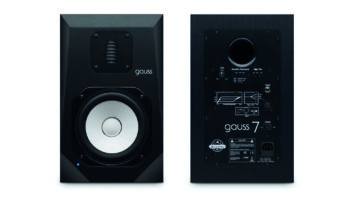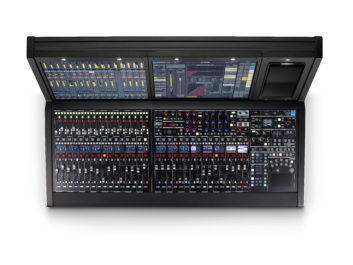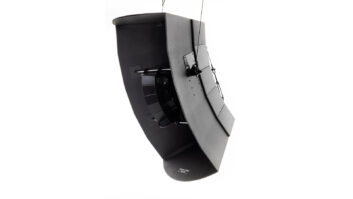MOTU UltraLite-mk5 Audio Interface
 Taking advantage of the latest ESS Sabre32 DAC technology, the MOTU UltraLite-Mk5 multichannel USB audio interface is capable of delivering a dynamic range of 125 dB and THD+N rated at -114. The UltraLite-Mk5 supports 40 simultaneous channels of audio I/O (18×22), including 2 front-panel mic/line/instrument inputs, 6 rear-panel balanced TRS inputs,10 rear-panel balanced TRS outputs, ADAT (8-channel) or TOSLink (2-channel) optical I/O, SPDIF I/O and a stereo headphone output. The front-panel mic inputs provide up to 74 dB of gain and feature individual switches for 48-volt phantom power and 20dB pad. A high-res OLED display on the front panel allows precision metering for all analog I/O. The UltraLite-mk5 operates at sample rates ranging from 44.1 to 192 kHz, and utilizes drivers optimized to deliver extremely low-latency. The unit includes onboard DSP, mixing and effects, and can be controlled with MOTU’s CueMix 5 app. Each analog input to CueMix 5 can be processed with a 4-band parametric EQ, gate and compressor, while output buses feature a 3-band parametric EQ. Six independent stereo mixes can be created in CueMix 5, enabling the UltraLite-Mk5 to generate independent mixes for monitors and headphone cues.
Taking advantage of the latest ESS Sabre32 DAC technology, the MOTU UltraLite-Mk5 multichannel USB audio interface is capable of delivering a dynamic range of 125 dB and THD+N rated at -114. The UltraLite-Mk5 supports 40 simultaneous channels of audio I/O (18×22), including 2 front-panel mic/line/instrument inputs, 6 rear-panel balanced TRS inputs,10 rear-panel balanced TRS outputs, ADAT (8-channel) or TOSLink (2-channel) optical I/O, SPDIF I/O and a stereo headphone output. The front-panel mic inputs provide up to 74 dB of gain and feature individual switches for 48-volt phantom power and 20dB pad. A high-res OLED display on the front panel allows precision metering for all analog I/O. The UltraLite-mk5 operates at sample rates ranging from 44.1 to 192 kHz, and utilizes drivers optimized to deliver extremely low-latency. The unit includes onboard DSP, mixing and effects, and can be controlled with MOTU’s CueMix 5 app. Each analog input to CueMix 5 can be processed with a 4-band parametric EQ, gate and compressor, while output buses feature a 3-band parametric EQ. Six independent stereo mixes can be created in CueMix 5, enabling the UltraLite-Mk5 to generate independent mixes for monitors and headphone cues.
Antelope Audio Axino Modeling Microphone
Antelope Audio’s new Axino Synergy Core is a USB cardioid condenser modeling microphone/interface  based around the company’s Modeling Engine, proprietary Synergy Core effects platform, and 24-bit/192 kHz AD/DA conversion. The Axino Synergy Core offers a large, gold-spluttered diaphragm with a cardioid pickup pattern and a built-in preamp, and it comes with USB cable, shock-mount and stand. The Axino Synergy Core’s Modeling Engine includes 18 mic emulations, ranging from dynamic designs to rare tube and FET large-diaphragm condenser classics. Emulations can be used in real-time while recording/monitoring, or later when mixing in a DAW in order to provide flexibility after the fact. Physical controls on the mic itself include volume and headphone volume controls, as well as a -10dB pad switch and a highpass filter switch. The Axino Synergy Core also comes with various Synergy Core effects; processing during post-production and live streaming is also possible by making use of the included loopback functionality.
based around the company’s Modeling Engine, proprietary Synergy Core effects platform, and 24-bit/192 kHz AD/DA conversion. The Axino Synergy Core offers a large, gold-spluttered diaphragm with a cardioid pickup pattern and a built-in preamp, and it comes with USB cable, shock-mount and stand. The Axino Synergy Core’s Modeling Engine includes 18 mic emulations, ranging from dynamic designs to rare tube and FET large-diaphragm condenser classics. Emulations can be used in real-time while recording/monitoring, or later when mixing in a DAW in order to provide flexibility after the fact. Physical controls on the mic itself include volume and headphone volume controls, as well as a -10dB pad switch and a highpass filter switch. The Axino Synergy Core also comes with various Synergy Core effects; processing during post-production and live streaming is also possible by making use of the included loopback functionality.
Audix A127 Omnidirectional Metal Film Condenser Mic
 Audix has released the new A127 Omnidirectional Metal Film Condenser Microphone, intended for use in professional studio recording, broadcast, film and sound design. The A127 ws designed around a reference-grade capsule (Type 1 IEC 61094-4 compliant) with a precision-tensioned, ultrathin, 3-micron metal film diaphragm that is a half-inch in size. With its omnidirectional polar pattern, the A127 can be used as a room mic or incorporated into a variety of stereo miking techniques. The mic is spec’d with a frequency response of 10 Hz – 20 kHz, a dynamic range of 133 dB and a self-noise of 7 dBA. A series of driven shields protects the microphone from external interference and capacitive coupling; the internal circuitry and mechanical components, including the gold-plated shield and precision-machined, corrosion-resistant housing, are designed and machined by Audix in its U.S. facility.
Audix has released the new A127 Omnidirectional Metal Film Condenser Microphone, intended for use in professional studio recording, broadcast, film and sound design. The A127 ws designed around a reference-grade capsule (Type 1 IEC 61094-4 compliant) with a precision-tensioned, ultrathin, 3-micron metal film diaphragm that is a half-inch in size. With its omnidirectional polar pattern, the A127 can be used as a room mic or incorporated into a variety of stereo miking techniques. The mic is spec’d with a frequency response of 10 Hz – 20 kHz, a dynamic range of 133 dB and a self-noise of 7 dBA. A series of driven shields protects the microphone from external interference and capacitive coupling; the internal circuitry and mechanical components, including the gold-plated shield and precision-machined, corrosion-resistant housing, are designed and machined by Audix in its U.S. facility.
Avantone Pro Gauss 7 Studio Monitors
Avantone Pro has launched Gauss 7, an active, full-range, two-way reference monitor that aims to  evoke a vintage sound with the addition of modern technologies. The 2.5-inch GAU-AMT tweeter (60 W) has a 65mm PET (Polyethylene Terephthalate) film-folded membrane, with an aluminum-etched PET film, folded. The cone for the 7-inch Ferrite Motor low-frequency driver (120W) is a pressed design, fabricated from the same proprietary blend of wood pulp and glass fiber found in the company’s CLA-10 Series AV10-MLF woofer, but with increased low end. Specs include 103 dB (Peak) SPL; and 0.5% THD delivered from an enclosure measuring 15 x 9.25 x 8.35 inches, and each monitor weighs 18 pounds. Connections include balanced XLR and 1⁄4-inch TRS inputs, plus a three-position Acoustic Placement switch, a three-position High Trim switch and a Gain control.
evoke a vintage sound with the addition of modern technologies. The 2.5-inch GAU-AMT tweeter (60 W) has a 65mm PET (Polyethylene Terephthalate) film-folded membrane, with an aluminum-etched PET film, folded. The cone for the 7-inch Ferrite Motor low-frequency driver (120W) is a pressed design, fabricated from the same proprietary blend of wood pulp and glass fiber found in the company’s CLA-10 Series AV10-MLF woofer, but with increased low end. Specs include 103 dB (Peak) SPL; and 0.5% THD delivered from an enclosure measuring 15 x 9.25 x 8.35 inches, and each monitor weighs 18 pounds. Connections include balanced XLR and 1⁄4-inch TRS inputs, plus a three-position Acoustic Placement switch, a three-position High Trim switch and a Gain control.
Celestion TFX0515 Small-Format Coaxial Driver
Celestion’s TFX0515 Small-Format Coaxial Driver is a 5-inch, ferrite-magnet, coaxial speaker with a  1.5-inch diameter polyimide low-frequency voice coil. High-frequency reproduction is handled by a high-sensitivity, 1-inch, silk-dome tweeter driven by a compact neodymium magnet motor. The use of neodymium yields a significant reduction in size of the HF structure, enabling it to be positioned at the acoustic center of the LF driver’s voice coil, ensuring that the drivers are time-aligned. The cone of the LF driver is made from Kevlar-loaded paper and employs an elastomer surround for durability. Recommended crossover frequency is 2,000 Hz. Frequency range is stated as 80 Hz to 20 kHz, with an overall sensitivity rating of 89 dB (1 watt @ 1 meter). Nominal power handling is 150 watts, while continuous power is rated as 300 watts. Impedance is spec’d as 8 Ohms. The TFX0515 mounts in a 4.6-inch cutout and weighs in at 3.5 pounds.
1.5-inch diameter polyimide low-frequency voice coil. High-frequency reproduction is handled by a high-sensitivity, 1-inch, silk-dome tweeter driven by a compact neodymium magnet motor. The use of neodymium yields a significant reduction in size of the HF structure, enabling it to be positioned at the acoustic center of the LF driver’s voice coil, ensuring that the drivers are time-aligned. The cone of the LF driver is made from Kevlar-loaded paper and employs an elastomer surround for durability. Recommended crossover frequency is 2,000 Hz. Frequency range is stated as 80 Hz to 20 kHz, with an overall sensitivity rating of 89 dB (1 watt @ 1 meter). Nominal power handling is 150 watts, while continuous power is rated as 300 watts. Impedance is spec’d as 8 Ohms. The TFX0515 mounts in a 4.6-inch cutout and weighs in at 3.5 pounds.
Zeppelin Cortado MkIII Contact Microphone
Zeppelin Design Labs, Chicago, has released the Cortado MkII, a rugged, versatile, easy-to-use  contact mic that is equally useful for sound design, music recording, and venue sound reinforcement. The sensor head attaches easily to most surfaces with clamp, tape or putty, and is tethered to the preamp chassis with a 6-foot (2m) shielded cable. Features include: sensitive piezo sensor; rugged steel enclosures; balanced and buffered signal for wide bandwidth and low noise floor; phantom-powered preamp circuit; built-in -10dB pad; and Bass Boost for extended low-end response. The available accessory kit includes a variety of clamps and adhesives to easily attach the Cortado, temporarily or permanently, to nearly any object or surface.
contact mic that is equally useful for sound design, music recording, and venue sound reinforcement. The sensor head attaches easily to most surfaces with clamp, tape or putty, and is tethered to the preamp chassis with a 6-foot (2m) shielded cable. Features include: sensitive piezo sensor; rugged steel enclosures; balanced and buffered signal for wide bandwidth and low noise floor; phantom-powered preamp circuit; built-in -10dB pad; and Bass Boost for extended low-end response. The available accessory kit includes a variety of clamps and adhesives to easily attach the Cortado, temporarily or permanently, to nearly any object or surface.
Cranborne Audio N22H Headphone Amplifier
The Cranborne Audio N22H Reference-Grade Headphone Amplifier was designed for tracking, mixing  or mastering, with a robust steel enclosure that can be positioned just about anywhere. The flat frequency response and ultra-low distortion was derived from the technologies in the company’s 500R8 interface, ensuring clean, transparent power. Users can switch from tracking with high-impedance, over-ear headphones or low-impedance, in-ear monitors with the flick of a switch between high and low power modes. A custom, logarithmic level control allows performers to control the headphone output without major increases in volume. The N22H can be powered by the included 9V DC power supply, any guitar pedal power supply, pedalboard power supplies, or a 9V battery that provides up to 10 hours of operation. It can also be positioned anywhere within 330 feet using a single, shielded CAT-5e, CAT-6, or CAT-7 cable and the Cranborne Audio C.A.S.T. system.
or mastering, with a robust steel enclosure that can be positioned just about anywhere. The flat frequency response and ultra-low distortion was derived from the technologies in the company’s 500R8 interface, ensuring clean, transparent power. Users can switch from tracking with high-impedance, over-ear headphones or low-impedance, in-ear monitors with the flick of a switch between high and low power modes. A custom, logarithmic level control allows performers to control the headphone output without major increases in volume. The N22H can be powered by the included 9V DC power supply, any guitar pedal power supply, pedalboard power supplies, or a 9V battery that provides up to 10 hours of operation. It can also be positioned anywhere within 330 feet using a single, shielded CAT-5e, CAT-6, or CAT-7 cable and the Cranborne Audio C.A.S.T. system.
Lawo 48-Fader mc²36 Console
Lawo’s “second-generation” mc²36 audio production console is based around a dual-fader operating  bay featuring 48 faders in the same space as a 32-fader board, making it ideal for theater, houses of worship, corporate, live and broadcast audio applications. Available DSP has more than doubled due to the built-in A__UHD Core functionality. It now offers 256 processing channels, available at both 48 and 96 kHz, and natively supports ST2110, AES67, RAVENNA, and Ember+. It provides an I/O capacity of 864 channels, with local connections that include three redundant IP network interfaces, 16 Lawo-grade mic/line inputs, 16 line outputs, eight AES3 inputs and outputs, eight GPIO connections, and an SFP MADI port. Other features include Button-Glow and touch-sensitive rotary controls, color TFT fader-strip displays, LiveView video thumbnails, and 21.5-inch full HD touchscreen controls. Its built-in full loudness control is compliant with the ITU 1770 (EBU/R128 or ATSC/A85) standard.
bay featuring 48 faders in the same space as a 32-fader board, making it ideal for theater, houses of worship, corporate, live and broadcast audio applications. Available DSP has more than doubled due to the built-in A__UHD Core functionality. It now offers 256 processing channels, available at both 48 and 96 kHz, and natively supports ST2110, AES67, RAVENNA, and Ember+. It provides an I/O capacity of 864 channels, with local connections that include three redundant IP network interfaces, 16 Lawo-grade mic/line inputs, 16 line outputs, eight AES3 inputs and outputs, eight GPIO connections, and an SFP MADI port. Other features include Button-Glow and touch-sensitive rotary controls, color TFT fader-strip displays, LiveView video thumbnails, and 21.5-inch full HD touchscreen controls. Its built-in full loudness control is compliant with the ITU 1770 (EBU/R128 or ATSC/A85) standard.
PreSonus MicroStation BT Monitor Controller
PreSonus has released the new MicroStation BT Bluetooth 5.0 stereo monitor controller, which can  receive audio from a phone, tablet or other Bluetooth source and feed it to powered speakers. The MicroStation BT also can be hardwired to a powered subwoofer to create a 2.1 listening environment. A stereo 1/8-inch input is also provided; a Bluetooth On/Off button toggles between Bluetooth and analog sources. Other onboard inputs include balanced left and right ¼-inch TRS inputs, which can route audio from pro-audio hardware to speakers, while the balanced ¼-inch TRS or unbalanced RCA Subwoofer outputs can send audio to a sub. An 1/8-inch stereo headphone/aux output lets users connect headphones or send stereo audio for streaming, recording and more. The main control is a large, ergonomic Volume knob for the overall level of connected speakers and subwoofer. A Sub Bypass button mutes the subwoofer feed, while a main Mute button silences speakers or headphones as needed.
receive audio from a phone, tablet or other Bluetooth source and feed it to powered speakers. The MicroStation BT also can be hardwired to a powered subwoofer to create a 2.1 listening environment. A stereo 1/8-inch input is also provided; a Bluetooth On/Off button toggles between Bluetooth and analog sources. Other onboard inputs include balanced left and right ¼-inch TRS inputs, which can route audio from pro-audio hardware to speakers, while the balanced ¼-inch TRS or unbalanced RCA Subwoofer outputs can send audio to a sub. An 1/8-inch stereo headphone/aux output lets users connect headphones or send stereo audio for streaming, recording and more. The main control is a large, ergonomic Volume knob for the overall level of connected speakers and subwoofer. A Sub Bypass button mutes the subwoofer feed, while a main Mute button silences speakers or headphones as needed.
Sonible Smart:EQ 3
 Plug-ins based on artificial intelligence are getting more powerful, and Sonible is one of the most experienced developers in that area. Its newest release, Smart:EQ 3 analyzes a section of the source you insert it on, and its AI engine creates a custom Smart Filter (EQ curve) to get rid of unwanted resonances and notches and provide a spectrally balanced result. Profiles are included for common instruments that “prime” Smart:EQ 3 to get the best results. You can also create your own Profiles and store them. Sonible redesigned the GUI in version 3 and added some new features, most notably Group view. You can add up to six instances of Smart:EQ 3 to a group and designate a hierarchy between them. The plug-in uses “intelligent cross-channel processing” to make adjustments to reduce masking between tracks. The Dynamic Adaptation option is also new. Turn it on and the instance of Smart:EQ 3 in use will adapt itself to changes in the music in real time.
Plug-ins based on artificial intelligence are getting more powerful, and Sonible is one of the most experienced developers in that area. Its newest release, Smart:EQ 3 analyzes a section of the source you insert it on, and its AI engine creates a custom Smart Filter (EQ curve) to get rid of unwanted resonances and notches and provide a spectrally balanced result. Profiles are included for common instruments that “prime” Smart:EQ 3 to get the best results. You can also create your own Profiles and store them. Sonible redesigned the GUI in version 3 and added some new features, most notably Group view. You can add up to six instances of Smart:EQ 3 to a group and designate a hierarchy between them. The plug-in uses “intelligent cross-channel processing” to make adjustments to reduce masking between tracks. The Dynamic Adaptation option is also new. Turn it on and the instance of Smart:EQ 3 in use will adapt itself to changes in the music in real time.







